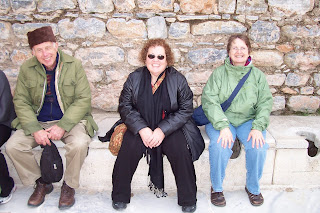
First we drove up a hill to a secluded house where, according to tradition, Mary the mother of Jesus, lived out her final days. Apparently the apostle John brought her to Ephesus when he came. This house has been made into a chapel for contemplation and is overseen by an order of nuns. We visited with one serving here now who comes from New York state. I lit a candle for my mother-in-law, a devoted Catholic who prays to the blessed mother.
We then drove down the hill, so that we could enter the site of Ephesus through the upper gate. We walked down what would have been the main street.

The covered sidewalks had mosaics, we saw “board” games etched into some of the “pavement,” and we found various kinds of crosses in lintels and posts. We visited the public baths and toilets.
 We saw the odion (a small version of theater, indoors, and used by the senators) and the agora (shops).
We saw the odion (a small version of theater, indoors, and used by the senators) and the agora (shops). My favorite, however, was the library!
 While it held fewer volumes than the one we saw at Pergamum yesterday, its walls were doubled in order to keep out moisture, and the structure was absolutely fabulous!
While it held fewer volumes than the one we saw at Pergamum yesterday, its walls were doubled in order to keep out moisture, and the structure was absolutely fabulous! Excavation and restoration work is ongoing in the “slope houses,” structures that would have been like garden homes for the rich. These houses were on the main street before the library. A roof covers the excavation/restoration site and work. Stairs and landings (built of clear plexiglass) allow visitors to walk inside and view the ongoing work from various levels. This was absolutely astounding to see: frescoes on the walls, mosaics on the floors, marble walls and ornate columns—inside the buildings.

After viewing the slope houses and the library, we continued down the main road towards what would have been the harbor. We walked among the ruins of the church of Mary. It was probably a warehouse (in the harbor district) before the Christians used it as a church. I like the idea that these early Christians needed a place to worship and used what was available—a warehouse.
 It serves as precedent for my own home church, Grace Presbyterian in Round Rock. We worshiped in our pastor’s living room, the neighborhood park, a house undergoing remodeling, a funeral parlor, and a farmhouse (starting with the garage) as we were forming into a fellowship, new church development, and a chartered church.
It serves as precedent for my own home church, Grace Presbyterian in Round Rock. We worshiped in our pastor’s living room, the neighborhood park, a house undergoing remodeling, a funeral parlor, and a farmhouse (starting with the garage) as we were forming into a fellowship, new church development, and a chartered church. The last ruin we visited today was the church of St. John Basilica. This was a huge church built by Emperor Justinian about the same time as the Hagia Sophia.
 St. John is supposed to be buried in this church. The baptistery is shaped like a cross. Located centrally in the worship space with steps at both ends, it reminded me of the baptistery at St. John Vianney Catholic Church in Round Rock. I wonder if the newly baptized members entered at one end (walked down into the waters) to signify death to the old life and exited (walked up) at the other end to signify rebirth into a new life.
St. John is supposed to be buried in this church. The baptistery is shaped like a cross. Located centrally in the worship space with steps at both ends, it reminded me of the baptistery at St. John Vianney Catholic Church in Round Rock. I wonder if the newly baptized members entered at one end (walked down into the waters) to signify death to the old life and exited (walked up) at the other end to signify rebirth into a new life. 
We ended our time in Ephesus in the museum, taking note of the many statues and relief recovered at the site.
Here are more Ephesus site pictures.

No comments:
Post a Comment